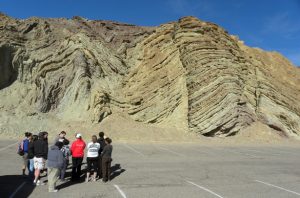This week will focus on the structural geology and tectonics of the Mojave region. Some of you have completed the structural geology course (Geology 313); others of you are in it right now; still others can only dream of it in the future. We know this and will review most terminology for you, but you want to at least visit again the structural sections of your Geology 200 notes.
Please return to the USGS Mojave National Preserve website and review the section on the general geological history of the Mojave Desert and the portion covering faults and active tectonics. We will discuss the San Andreas and Garlock faults, both of which are described at the Southern California Earthquake Data Center. The USGS also has a very brief introduction to the San Andreas fault. Both of these faults simulate strike-slip motion, but strike-slip faults can be very complex. Do you remember structural vocabulary such as flower structures, releasing vs. restraining bends and transpression vs. transtension? If not, Wikipedia has a quick vocabulary review of each. You’ll also want to become comfortable with other fault vocabulary such as normal faults, reverse/thrust faults, dip slip faults, and oblique faults.
If you have time, please review the geological history of Death Valley itself as presented by the National Park Service, along with the USGS webpages on Death Valley through time. Death Valley is a spectacular place for all kinds of geology, from the Precambrian through modern desert processes, so we will return to it often in our introductory sections.
Geology in the News –
We have so much more to learn about human evolution. We’re not even done finding the most basic fossils. The latest is a set of hominid teeth in China between 60,000 and 120,000 years old. They are not Homo sapiens. They’re not any recognizable species.
There’s a new set of survey results out on Americans and their perception of science and scientists. It is, of course, not good news when it comes to the acceptance of evolution or climate change. We’ll let a snarky British newspaper tell the story.
I didn’t think of this one: Climate change may mean more volcanic eruptions in Iceland. By melting more ice off the island, it gets lighter and rises. This in turn decreases pressure on the subterranean magma bodies, causing more to erupt lava on the surface. This can’t be good news for us.

